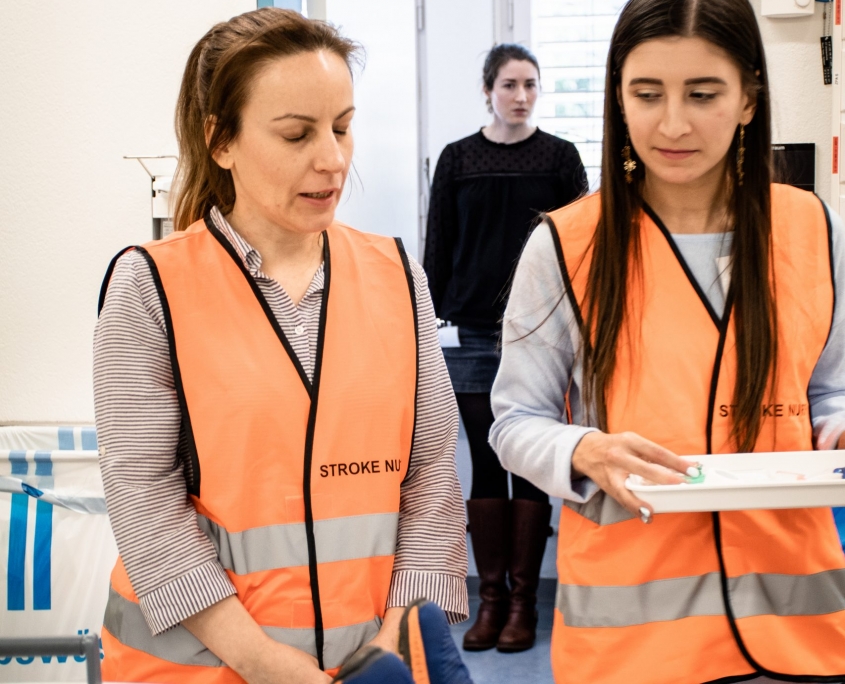By Alex Alban Christensen, Odense, Denmark
Flying into Switzerland, this amazing country of multilinguism, direct democracy, technology, fantastic nature and its very own take on European culture, our high expectations were initially hampered by a greeting of pouring rain.
Luckily those of us that had done their homework had brought umbrellas.
We found our way to the Inselspital and the SITEM, a newly constructed glassy framed building, being home to a 7 Tesla MRI for research purposes as well as to the Stroke Winter School for the upcoming 4 days, while offering spectacular views of the Jungfrau, Eiger and Mönch mountain range.
The last accreditations were retrieved with anticipation, and then, the alphorns sounded to kick off the lectures. Precision and punctuality are known as Swiss attributes, and it was noted that even the Italians were on time!
The course aimed to bring young neurologists and neurointerventionalists together and take new knowledge and inspiration home to their respective stroke settings and networks, and we thus arrived as teams of two, consisting of one neurologist and one neurointerventionalist.
To facilitate participation from all around Europe and beyond, the course fee including hotel costs, delightful 3 course dinners every night, local transport – and of course the first cocktail in the Abflugbar – was kept very low, or as ESO President elect Dr. Bart van der Worp explained, the cost of two newly released Swiss 1/4 Franc gold coins in the Albert Einstein version.
The Swiss surely know a thing or two about economics!
The lectures, provided by local and international experts, had a general focus on acute stroke treatment, but there were also important slots for topics like preventional medicine, palliation in stroke or the organization of a stroke network. Imagine the best of lectures in the bigger conferences in an intimate setting, and you have the Stroke winter school 2020.
There were workshops with practical simulations for the interventionalists that were very well received, and the neurologists went through an emergency room stroke simulation as well as workshops with interventionalists, were treatment choices and perspectives could be discussed.
The tone throughout was jovial and informal, and discussion and questions were strongly encouraged. There could be no doubt of the sincere goal of the organizers and faculty members to make this the very best experience possible for the participants, with the larger perspective of improving future stroke care in the respective local setting.
A main focus of a joint ESO-ESMINT course was to strengthen the relationship between the teaming neurologist and neurointerventionalist. It may sound trivial, but there is a real value in getting better understanding for the issues that our close colleagues in stroke treatment are facing. Even before this course, I have personally seen this need, and felt that we should talk plenty more!
We should not work in our own disciplines for ourselves, but together as a team, which will both make it more fun and lead to better results for our patients.
Personally, I now feel better prepared to discuss the pros and cons of thrombectomy via the ACOM or of the antegrade versus retrograde approach in a tandem lesion, and look forward to more dialogue. Finding this time in a busy day can be a problem, but is something that I will aim for.
Each night, we went out to dinner in amazing locations around Bern.
One highlight was taking the Gurtenbahn up to the 855 m hilltop of Gurten, overlooking Bern. Finally, we were treated to some snow, and those of use living in a snow deprived temperate climate rejoiced.
The view was fantastic as was the food, and in general the social events in the evenings gave us all, course participants and faculty members, a chance of getting to know each other and to exchange professional experiences, as well as needed conversations far away from work related topics.
On the day before departure, after dinner we were invited to the Abflugbar, or Departure bar, in central Bern, and we all had a great time socializing deep into the night. Rumors say that Bern`s nightlife was tested further afterwards.
To quote the farewell greetings of a young German colleague from the newly created Stroke Winter School 2020 WhatsApp group, it was an “inspiring week meeting so many unique, dedicated and smart doctors from all over Europe and beyond”.
I fully subscribe to this, and I am confident that all of you will go home and be a part of taking stroke medicine to the next level in your countries.
For young neurologists and neurointerventionalists reading this blog, participation in the ESO Stroke Winter School can only be encouraged. You will be happy to have been part of the experience.
On the last day, the sun was finally shining, as if the city wanted to bid us farewell in its full glory.
What a beautiful and unique city it is, and going back to our Danish island of Fyn, we will miss it.
















